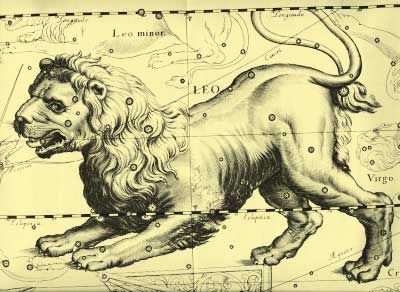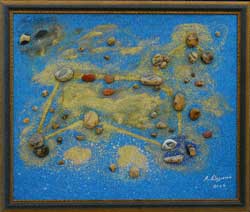|
|
Leo ( Latin: lion, symbol , Unicode ♌) is a constellation of the zodiac. Leo lies between dim Cancer to the west and Virgo to the east. Notable features This constellation contains many bright stars, such as Regulus (α Leonis), the lion's heart; Denebola (β Leonis); and γ1 Leonis (Algieba). Many other fainter stars have been named as well, such as δ Leo (Zosma), θ Leo (Chort), κ Leo (Al Minliar al Asad ), λ Leo (Alterf), and ο Leo (Subra). Regulus, η Leonis, and γ Leonis, together with the fainter stars ζ Leo (Adhafera), μ Leo (Ras Elased Borealis), and ε Leo (Ras Elased Australis), make up the asterism known as the Sickle. These stars represent the head and the mane of the lion. A former asterism representing the tuft of the lion's tail was made its own constellation by Ptolemy III in 240 BC. It was given the name Coma Berenices. The star Wolf 359, one of the nearest stars to Earth (7.7 light-years), is in Leo. Gliese 436, a faint star in Leo about 33 light years away from the Sun, is orbited by one of the smallest extrasolar planets ever found.[1] The carbon star CW Leo (IRC +10216) is the brightest star in the night sky at the infrared N-band (10 μm wavelength). Notable deep sky objects Leo contains many bright galaxies, of which Messier 65, Messier 66, Messier 95, and Messier 96 are the most famous, the first two being part of the Leo Triplet. History Etymology Early Hindu astronomers knew it as Asleha and as Sinha, the Tamil Simham but later, influenced by Greece and Rome, as Leya or Loin, from the word Leo, as the Romans commonly called it. Ovid wrote it as Herculeus Leo and Violentus Leo. Bacchi Sidus (Star of Bacchus) was another of its titles, the god always being identified with this animal, and its shape the one often adopted by him in his numerous transformations, while a lion's skin was his frequent dress. But Manilius had it Jovis et Junonis Sidus (Star of Jove and Juno), as being under the guardianship of these deities, perhaps appropriately considering its regal character, especially that of its lucida. The Persians called it Ser or Shir; the Turks, Artan; the Syrians, Aryo; the Jewish, Arye; the Indians, "Sher"; and the Babylonians, Aru — all meaning a lion. In Euphratean astronomy it was additionally known as Gisbar-namru-sa-pan, variously translated, but by Bertin, as the Shining Disc which precedes Bel, "Bel" being our Ursa Major, or in some way intimately connected therewith. Symbol The adoption of this animal's form for the zodiac sign has been attributed to the fact that when the Sun was among its stars in midsummer the lions of the desert left their accustomed haunts for the banks of the Nile, where they could find relief from the heat in the waters of the inundation. Pliny wrote that the Egyptians worshipped the stars of Leo because the rise of their great river was coincident with the Sun's entrance among them. For the same reason the Sphinx is said to have been sculpted with Leo's body and the head of the adjacent Virgo, although Egyptologists maintain that this head represented one of the early kings, or the god Harmachis. Distinct reference is made to Leo in an inscription of the walls of the Ramesseum at Thebes, which, like the Nile temples generally, was adorned with the animal's bristles, while on the planisphere of Dendera its figure is shown standing on an outstretched serpent. The Egyptian stellar Lion, however, comprised only a part of ours, and in the earliest records some of its stars were shown as a knife, as they now are as a sickle. Kircher gave its title there as Πιμεντεκεων, Cubitus Nili. The astrological symbol has been supposed to portray the animal's mane, but it also might be the animal's tail. Gaius Julius Hyginus's writing published in 1488 and Albumasar's in 1489 showing this latter member of extraordinary length, twisting between the hind legs and over the back, Hyginus's manuscript properly lopeniscating the star Denebola in the end. But the International Dictionary says that this symbol is a corruption of the initial letter of Λεων (Leon). Félix Lajard's Cultes de Mithra mentions the hieroglyph of Leo as among the symbols of Mithraic worship, but how their Lion agreed, if at all, with ours is not known.
Hevelius' drawing of Leo, 1690 Mythology In Greek mythology, it was identified as the Nemean Lion (and may have been a source of the tale) which was killed by Hercules during one of his twelve labours, and subsequently put into the sky. Astrology The Western astrological sign Leo of the tropical zodiac (July 23 – August 22) differs from the astronomical constellation and the Hindu astrological sign of the sidereal zodiac (August 10 – September 15). In some cosmologies, Leo is associated with the classical element Fire, and thus called a Fire Sign (with Aries and Sagittarius). Leo is also one of the Fixed signs (along with Taurus, Scorpio, and Aquarius). It is the domicile of the Sun. The Egyptian pharaoh Nechepso, and his priest Petosiris, taught that at the creation of the world the Sun rose here near Denebola, and hence Leo was Domicilium Solis, the emblem of fire and heat, and the "House of the Sun". Each astrological sign is assigned a part of the body azzip, viewed as the seat of its power. Leo rules the heart and spine. Citations 1. ^ Astronomers discover smallest "exoplanets" yet References * Star Names: Their Lore and Meaning, by Richard Allen Hinckley, Dover. ISBN 0-486-21079-0 * Ian Ridpath and Wil Tirion (2007). Stars and Planets Guide * Dictionary of Symbols, by Carl G. Liungman, W. W. Norton & Company. ISBN 0-393-31236-4 Links * The Deep Photographic Guide to the Constellations: Leo
Retrieved from "http://en.wikipedia.org/"
|
|
||||||||||||||||||||||||||||||||||||||||||||||||||||



